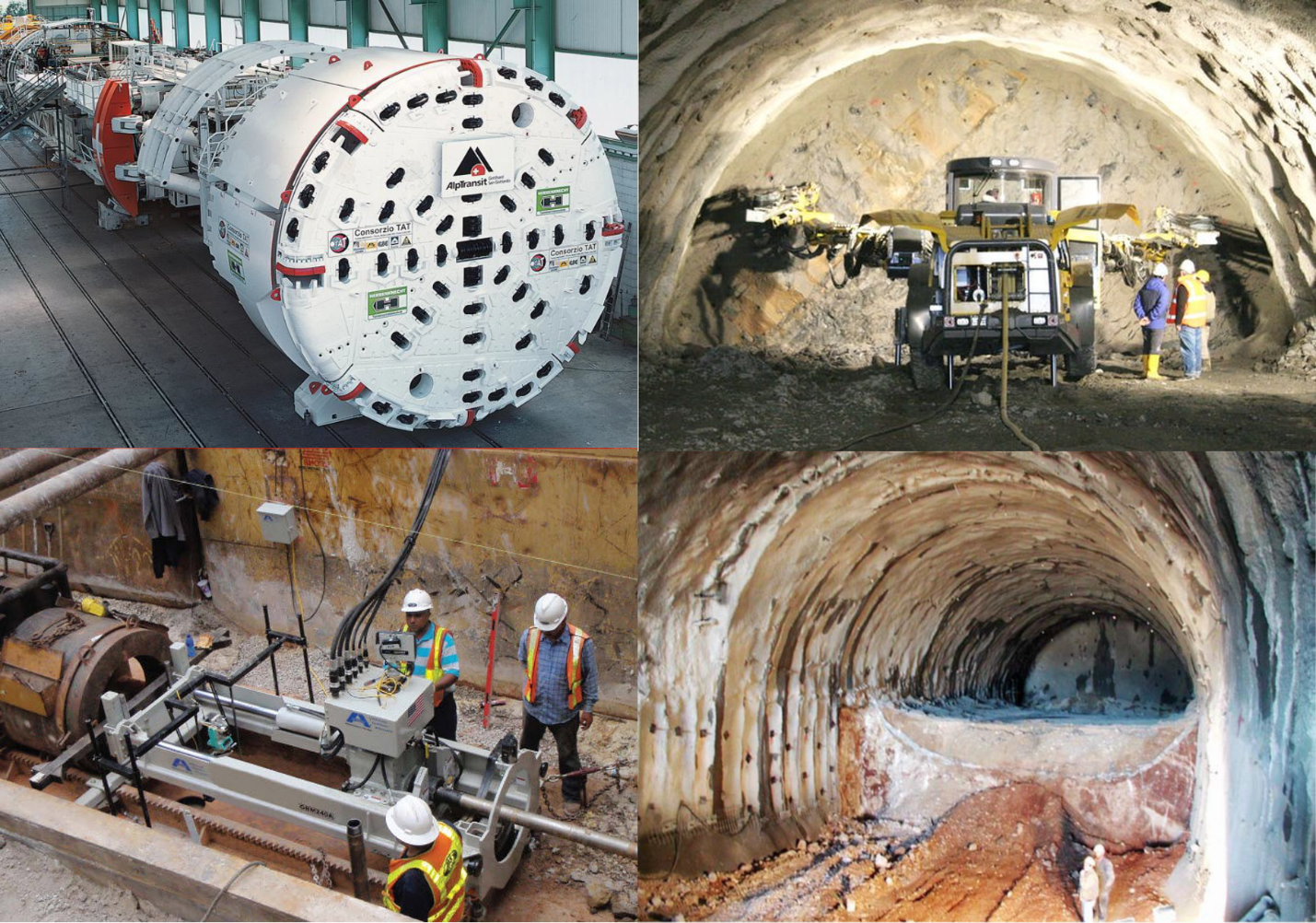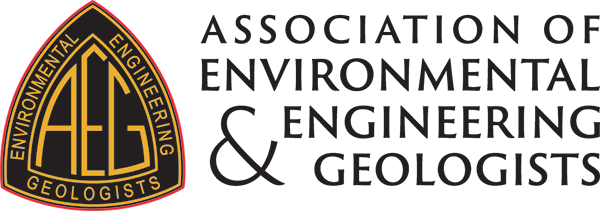AEG Tunneling Workgroup Technical Resources
Group Responsibilities:
This Technical Working Group has the responsibility of reviewing environmental, engineering geology and geotechnical questions and issues related to feasibility, planning, design, construction, rehabilitation, and maintenance of tunnels and underground structures (tunnels, shafts, & caverns). The group makes recommendations to the Board for consideration with respect to position or policy statements on tunnels and underground structure related matters. The technical working group activities include:
- Informing our membership of new and emerging technologies
- Improving public awareness of tunneling and underground projects (tunnels, shafts, & caverns) and promoting our profession
- Improving public awareness of societal benefits associated with development of underground infrastructure
- Providing input to local, state, or federal regulations impacting underground infrastructure
- Outreach to high schools and universities regarding careers in underground engineering
- Publishing papers and organizing AEG Tunneling Symposia and Short Courses
Chairs: Paul Headland, Ike Isaacson, and Michael Piepenburg
Website Content: Ashton Krajnovich
Tunneling Overview:
Tunnels provide long-term solutions to a variety of infrastructure projects ranging from constructing roadways or pipelines through difficult terrain to freeing up valuable surface space in dense urban areas. In recent years, the rapid expansion of metropolitan areas has led nations around the world to give more and more consideration to the upfront investment of tunneling projects in order to promote more efficient use of surface space and recognize the significant benefits to society at large.
Geological Engineering in Tunneling:
Tunneling is a unique field, requiring geological, geotechnical, mining and civil engineers to work together with construction contractors and government agencies to deliver resilient and reliable subsurface infrastructure. Engineering Geologists and Geological Engineers bridge the gap between site characterization and tunnel construction, acting as a cornerstone of this interdisciplinary team. Roles of the Engineering Geologist and Geological Engineer in a tunnel/underground project include:
- Site characterization, including subsurface geology and pre-existing infrastructure
- Alignment optimization based upon ground conditions/ground behavior
- Development of Ground Model based upon understanding of ground conditions and ground behavior for site characterization and ground risk/hazard identification
- Identifying and managing geologic hazards (e.g., groundwater, problematic ground conditions, impacts to existing utilities and adjacent structures)
- Recommending appropriate excavation and ground support methods
- Recommending appropriate groundwater control measures
- Recommending appropriate pre-excavation support/ground improvement measures
- Estimating project design and construction schedules and costs
- Conducting resilience and reliability analyses
- Enabling effective communication within interdisciplinary teams
- Participation in project Risk Management process
- Participating in public outreach efforts associated with underground infrastructure projects
Types of Tunnels:
Planning the approach to any tunnel/underground project requires careful consideration of geologic setting, ground condition, ground behavior, and development of a engineering geological model to assist the design team in decision making and design parameters for evaluation of construction methods, control of groundwater, design of temporary support, and design of final linings. A clear understanding of the site-specific ground conditions and ground behavior drive the development of the excavation methods used for underground structures. Excavation methods include the following:
- Tunnel Boring Machines (TBM) – greater than 3m diameter (man access)
- Drill and Blast
- Sequential Excavation Method (SEM)
- Microtunnel Boring Machines (MTBM) – less than 3m diameter (no man access)
The excavation method is selected to optimize construction efficiency and ensure safety of construction personnel and the public during construction.

Tunneling methods (clockwise from top left): TBM, Drill and Blast, SEM and MTBM. Images obtained from Heitkampt-swiss.ch, Akkerman.com and Hoek et al., 2007.
Beyond the understanding of the project geologic site conditions, the final use of the tunnel is also important. Underground structures need to be built in specific locations for specific end uses, with certain required dimensions based upon the requirements of the owner and funding agencies who are responsible for the long-term operation and maintenance of the infrastructure. Furthermore, tunnels need to satisfy certain resilience and reliability measures based on their use type (roadway tunnel, aqueduct, mine shaft). Every tunneling project is unique due to these many factors, each requiring a thorough geological site investigation, site characterization, and provision of geotechnical design parameters to ensure sound design, safe and efficient construction, and long-term performance and operation.
Tunneling Case Studies:
Tunneling mega projects with billion-dollar price tags are growing in popularity all over the world. Two modern projects, the Alaskan Way Viaduct Replacement Tunnel (AWVRT) in Seattle (5 years, $2.8 billion) and the Gotthard Base Tunnel (GBT) in Switzerland (11 years, $9.5 billion), highlight the risks, and rewards, of tunneling mega projects.
Other notable completed/ongoing projects include:
Urban: Boston “Big Dig”, NYC East Side Access, San Franciso Trans Bay Terminal
Underwater: Channel Tunnel, Oresund Bridge/Tunnel, Hong Kong-Zhuhai-Macau Bridge/Tunnel
Mountain: Eisenhower Johnson Memorial Tunnels, Gotthard Base Tunnels
Technical References
Don Deere Lectures & Videos
- (possible future addition)
Selected Papers
- Ground Water Manual, 1995. US Department of the Interior, Bureau of Reclamation. https://www.usbr.gov/tsc/techreferences/mands/mands-pdfs/GndWater.pdf
- FHWA-NHI-10-034, Technical Manual for Design and Construction for Road Tunnels – Civil Elements, 2009. Federal Highway Administration, U.S. Department of Transportation. https://www.fhwa.dot.gov/bridge/tunnel/pubs/nhi09010/tunnel_manual.pdf
- ASTM D-7625, Standard Test Method for Laboratory Determination of Abrasiveness of Rock Using the CERCHAR Method, 2010. http://www.astm.org/cgi-bin/resolver.cgi?D7625
- ASTM D-2487, Standard Practice for Classification of Soils for Engineering Purposes (Unified Soil Classification System), 2006. http://www.astm.org/cgi-bin/resolver.cgi?D2487-06
- Deere, D.U. and Deere, D.W., 1989. Rock Quality Designation (RQD) after Twenty Years. U.S. Army Corps of Engineers, Contract Report GL-89-1. https://apps.dtic.mil/dtic/tr/fulltext/u2/a207597.pdf
- Gamble, J. C, 1971. Durability-Plasticity Classification of Shales and Other Argillaceous Rocks. Ph.D. Thesis, University of Illinois at Urbana-Champaign. https://search.proquest.com/docview/302466643
- Rock Characterization, Testing and Monitoring: ISRM Suggested Method, 1981. International Society of Rock Mechanics. E.T. Brown (Ed.), Pergamon Press, Oxford. https://doi.org/10.1007/978-3-319-07713-0
- Terzaghi, K., 1950. Geologic Aspects of Soft Ground Tunneling. Chapter 11 in Applied Sedimentation, ed. P. Trask, John Wiley and Sons, New York. https://trid.trb.org/view/124782
- Frank, Glen and Chapman, D., 2001. Geotechnical Investigations for Tunneling in Glacial Soils. In: Proceedings of Rapid Excavation and Tunnelling Conference 2001, Society for Mining, Metallurgy, and Exploration, Littleton, CO, 309- 324.
- Deere, D.U. and Deere, D.W. 1988. The rock quality designation (RQD) index in practice. Rock classification systems for engineering purposes, (ed. L. Kirkaldie), ASTM Special Publication 984, 91-101. Philadelphia: Am. Soc. Test. Mat. https://web.mst.edu/~rogersda/umrcourses/ge341/The%20Rock%20Quality%20Designation%20(RQD)%20in%20Practice.pdf
- Heuer, Ronald E. 1974, Important Ground Parameters in Soft Ground Tunneling, in Subsurface Explorations for Underground Excavation and Heavy Construction, ASCE Specialty Conference; 41 – 55. https://cedb.asce.org/CEDBsearch/record.jsp?dockey=0023239
- Frank, Glen and Chapman, D., 2005, A New Model for Characterization of the Cobble and Boulder Fraction for Soft Ground Tunneling. In: Proceedings of Rapid Excavation and Tunnelling Conference 2005, Society for Mining, Metallurgy, and Exploration, Littleton, CO, 780-791.
- Terzaghi, K., 1946. Rock defects and loads on tunnel support. Rock tunneling with steel supports. (eds. R.V. Proctor and T.L. White), 1: 17–99. Youngstown, OH: Commercial Shearing and Stamping Company. http://www.scirp.org/(S(i43dyn45teexjx455qlt3d2q))/reference/ReferencesPapers.aspx?ReferenceID=1995284
- Thewes, M., 1999. Adhäsion von Tonböden beim Tunnelvortrieb mit Flüssigkeitsschilden (Adhesion of Clay Soils in Tunnel Driving Using Slurry Shields). Bergische Universität Gesamthochschule Wuppertal, Bodenmechanik und Grundbau, No. 21. https://www.researchgate.net/publication/295352978_Adhesion_of_clay_during_tunnel_drives_with_slurry-type_shield_machines
- Cording, E.J., and W.H. Hansmire., 1975. Displacements around soft ground tunnels. Proceedings in 5th Pan American Conference on Soil Mechanics and Foundation Engineering, 571–632.
- Peck, R.B. 1969. Advantages and limitations of the observational method in applied soil mechanics. Geotechnique, 19(1): 171–187. https://doi.org/10.1680/geot.1969.19.2.171
- Thewes M. and Burger W., 2004. Clogging Risks for TBM Drives in Clay. Tunnels & Tunneling International, 28-31. https://trid.trb.org/view/704775
- Goodman, R.E., Moye, D.G., Van Schalkwyk, A., and Javandel, I., 1965. Groundwater Inflows During Tunnel Driving. Engineering Geology, 1(1), 39–56. https://www.worldcat.org/title/ground-water-inflows-during-tunnel-driving/oclc/373897895
- Heuer, R., (1995) Estimating rock tunnel water inflow. In: Proceedings of Rapid Excavation and Tunnelling Conference 1995, Society for Mining, Metallurgy, and Exploration, 41–60.
- Heuer, R., (2005) Estimating rock tunnel water inflow—II. In: Proceedings of Rapid Excavation and Tunnelling Conference 2005, 394–407.
- Raymer, J.H., (2001) Predicting groundwater inflow into hard-rock tunnels: estimating the high-end of the permeability distribution. In: Proceedings of Rapid Excavation and Tunnelling Conference 2001, 1027–1038.
- Hoek, E. (1982). Geotechnical Considerations in Tunnel Design and Contract Preparation. Journal of Mines, Metals and Fuels, 30(11), 573–584. http://citeseerx.ist.psu.edu/viewdoc/download?doi=10.1.1.503.3840&rep=rep1&type=pdf
- Committee on Underground GeoEngineering for Sustainable Development (2013). Underground engineering for sustainable urban development. National Academy of Sciences. https://doi.org/10.17226/14670
AEG Tunneling Symposia Presentations
2018 IAEG Annual Meeting– Tunneling Symposium
- Don W. Deere – Tunnel Symposia Keynote: Lessons Learned from Dr. Don U. Deere, The Consummate Engineering Geologist
- Jeb Pittsinger – First Use of SEM Tunneling Methods in Vermont - Interstate 89 Culvert Replacement
- Jon Pearson – Culvert Construction under I-89 in Vermont using the Sequential Excavation Method
- Richard DePew – Tunnel Boring Machine Utilization as a Viable Alternative to Designed Hand Mining Methods on the Dugway South Relief Sewer Project
- Jon Y. Kaneshiro – Engineering Geological Considerations and Case Histories for Bored Tunnels in Mixed Face Rock/Soil Ground
- Peter Ellecosta – Wear Phenomena in TBM Hard Rock Drilling Reasons and Consequences
- Kurosch Thuro – Prediction of Drilling Rates and Bit Wear in Hard Rock Drill and Blast Tunneling
- Giulia Bossi – Four Years Monitoring Experience of Displacements induced by a Large Landslide in a Tunnel Serving a National Road
- Gary Brierley – Engineering Geology as Applied to Tunneling Projects
- Carrie Randolph Loar – Chimney Hollow Reservoir Inlet/Outlet Tunnel Geotechnical Investigation Design
- Emilio Linde-Arias – Development of the Ground Model and Depressurization Design for the Construction of a Cross Passage in London Tertiary Basin
- Kenneth Johnson – Estimating Groundwater Inflow in Tunneling: A Case History for the Lower Meramec Tunnel, St. Louis, MO
- Filipe Jeremias – Engineering Geological Studies for the New Drainage Tunnels of Lisbon
- Vasilis Kallimogiannis – ARMR, a Classification System for Rating of Anisotropic Rock Masses (Presented By Haris Saroglou)
- Ashton Krajnovich – A Bayesian Approach to Adaptive and Predictive 3-D Geologic Modeling for Tunneling Projects
- Nora Lewandowski – Updated PSHA for San Francisco Public Utilities Commission’s Mountain Tunnel, Sierra Nevada Foothills, California
- Masashi Nakaya – Fundamental Study on Three Dimensional Seismic Reflection Method using Excavation Blasting of Mountain Tunnel as Source
- Chunxiao Liu – Destruction Law of Rectangular Tunnel Structure Based on the Theory of Plastic Hinge
- Xiaojun Li – Stochastic, Goal-oriented Rapid Impact Modeling of Uncertainty and Environmental Impacts in Poorly-Sampled Sites Using Ex-Situ Priors
- Marlène Villeneuve – Using Tunnel Boring Machine Penetration Tests to Quantify Performance in Hard Rock
- Yiguo Xue – A New Risk Prediction Model of Water or Mud Inrush in a Cross-harbor Tunnel
- Kazuhiro Onuma – Evaluation Method for Rock Condition by Spectrogram of Seismic Waves Generated at Tunnel Excavation Blasting
Weblinks
Underground Construction Association: https://www.smenet.org/uca
International Tunneling and Underground Space Association: http://www.ita-aites.org/
Tunneling Association of Canada: http://www.tunnelcanada.ca/
Contact the Coordinator of Working Groups Chair or AEG headquarters to get involved.
|

